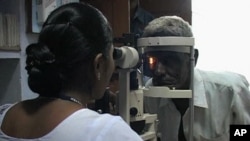Eye doctors in India are now able to treat patients in remote villages thanks to a new wi-fi video conferencing network.
In this eye clinic in Andipatti village in Tamil Nadu state, patients are seeing things a little differently.
Patient Rajamanickam complains about an eye injury.
And 15 kilometers away, an ophthalmologist at the Aravind Eye Hospital in the city of Theni diagnoses and treats him. Both are connected through an inexpensive wi-fi video conferencing network.
It is called "telemedicine" and it is increasing access to care in a country that is home to the world's largest number of blind people.
Eight vision centers have opened over the past six years in Theni district.
The centers are run by an ophthalmic assistant who is trained to conduct a full eye examination, administer diagnostic tests, treat simple ailments and prescribe glasses.
A doctor at centers as far as 150 kilometers away gives the final word to villagers.
"It is a useful instrument for the villagers. We can actually talk to the doctor directly from here," said Rajamanickam.
Rajamanickam normally would spend a full day traveling to the Aravind Eye Hospital. Instead, he traveled only three kilometers by local bus to this vision center in his village.
His exam cost about 50 cents, half what it would cost at the hospital. He saved $2 on transportation which he says he can now use for medicines.
The assistant also found a cataract in Rajamanickam's eye, which will require surgery at the hospital. Doctors say this early detection has prevented Rajamanickam from becoming blind.
Under the World Health Organization (WHO) 2020 initiative, India has pledged to eliminate avoidable blindness in 10 years.
The WHO reports that about a third of the world's 45 million blind people live in India. And the majority of causes such as cataracts and diabetes are treatable.
Aravind Eye Hospital has conducted mobile eye camps in villages across Tamil Nadu over the past two decades. Eye doctors have administered daylong screenings to roughly 750 patients each year.
Now, with the vision centers in place, doctors are treating an average of 5,000 patients per center per year.
Each center is connected to the main hospital by video towers, designed with the help of students at the University of California Berkeley in the United States. The towers cost $2,200 to set up, but very little to operate.
Dr. P. Namperumalsamy is chairman of Aravind Eye Hospital. He says the scarcity of doctors in India mades video treatment essential.
"You may say that you're not touching the patient, you're not talking to the patient, but it's all the more better. If left alone, what they do is will put native medicines or some unwanted medicines and spoil their eyes. This is better than that, and we can advise them the proper medicine for treatment," said Dr. Namperumalsamy.
The Indian government plans to set up 20,000 more rural vision centers in the coming years.














